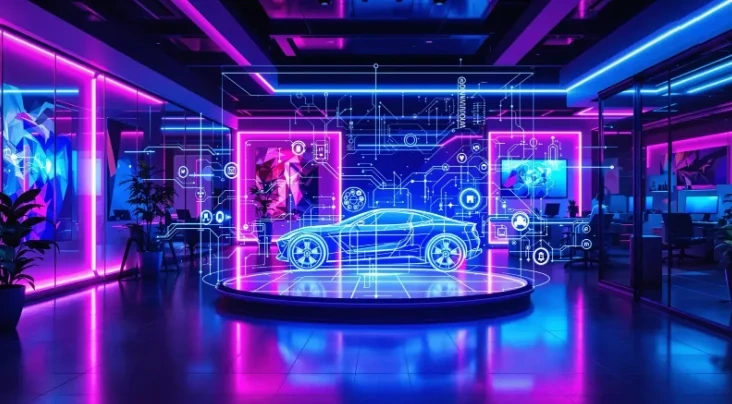Part 1: Generative AI in Business 2025: Real-World Applications and Strategic Advantages

Introduction
Generative AI has moved beyond a novelty; it’s a core business tool in 2025. This isn’t about futuristic possibilities; it’s about how businesses are today using generative AI to improve operations, enhance customer experiences, and gain a competitive edge. This post explores concrete applications of generative AI and provides a strategic framework for adoption, focusing on real-world impact and measurable ROI. For businesses looking to implement these powerful tools, resources like AI Startup LaunchPad offer practical guidance and support.
Read more: AI for Startups in 2025: The Definitive Guide to Growth, Funding, & Innovation
1. Understanding Generative AI: Beyond the Basics
Generative AI systems create new content – text, images, audio, code, and more – by learning patterns from vast datasets. While large language models (LLMs) from OpenAI (like GPT-4 and its successors) and image generators like DALL-E and Midjourney are well-known, the 2025 landscape is much broader. We’re seeing a rise in:
- Specialized Models: Models trained for specific tasks (e.g., code generation, medical text summarization) are often more efficient and accurate than general-purpose LLMs.
- Open-Source Alternatives: The open-source community is thriving, with models like Mistral AI’s offerings, Meta’s Llama 2, and DeepSeek Coder providing powerful and customizable options.
- Smaller, More Efficient Models: The trend is towards smaller language models (SLMs) that require less computational power and are easier to deploy.
Read more: Top AI Trends for Business in 2025
2. The Economic Impact: Generative AI is Driving Real Value
Generative AI isn’t just about cool demos; it’s about quantifiable business impact. The focus is on implementations that deliver a clear return on investment (ROI), including:
- Cost Reduction: Automating tasks, reducing manual labor, and optimizing processes.
- Revenue Growth: Improving customer engagement, personalizing experiences, and accelerating product development.
- Efficiency Gains: Streamlining workflows, reducing errors, and improving decision-making.
3. Industry-Specific Applications: Where Generative AI is Making a Difference
Let’s look at how different sectors are leveraging generative AI:
- High-Tech: Software development (code generation, debugging), content creation (marketing materials, documentation), and customer support (chatbots, personalized responses).
- Banking: Fraud detection, risk assessment, personalized financial advice, and automated report generation.
- Retail and CPG: Personalized product recommendations, dynamic pricing, supply chain optimization, and creation of marketing content (product descriptions, ad copy).
- Life Sciences: Drug discovery, personalized treatment plans, clinical trial optimization, and medical report summarization.
- Manufacturing: Predictive maintenance, generative design of parts, quality control (using computer vision), and process optimization.
4. Key Applications of Generative AI in Business: A Deep Dive
1. Content Creation and Personalization:
- Automated Content Generation: AI tools can generate blog posts, social media updates, email newsletters, website copy, and more. Beyond the well-known names (Jasper, Copy.ai), explore options like Rytr, Article Forge, Sudowrite, and Scalenut. For images, consider Leonardo.Ai alongside DALL-E and Midjourney.
- Hyper-Personalization: AI tailors content to individual customer preferences.
- Example: Coca-Cola uses generative AI to create diverse, on-brand marketing content.
2. Customer Service and Support:
- AI-Powered Chatbots: Advanced chatbots handle complex inquiries, provide 24/7 support, and personalize interactions. Platforms include Intercom, Drift, Ada, and open-source options like Rasa.
- Improved Efficiency: AI automates routine tasks, freeing up human agents.
- Example: Amazon uses LLMs in its customer service operations.
3. Data Analytics and Decision Making:
- Automated Reporting: AI generates comprehensive reports from complex datasets.
- Predictive Analytics: AI forecasts trends and outcomes. Tools like DataRobot and H2O.ai offer powerful predictive capabilities.
- Example: JPMorgan Chase uses AI for enhanced financial accuracy and efficiency.
4. Product Design and Development:
- Generative Design: AI algorithms generate innovative design concepts, impacting fields like architecture (Autodesk Forma) and industrial design.
- Rapid Prototyping: AI accelerates the process.
- Example: BMW uses generative AI for product innovation.
5. Software Development and Coding:
- AI-Powered Coding Assistants: GitHub Copilot, Tabnine, and Codeium help developers write code faster and with fewer errors.
- Increased Productivity: AI reduces development time.
5. Generative AI Adoption Trends: What to Expect in 2025
- Increased Spending: Enterprise spending on generative AI is skyrocketing.
- Open-Source Models Gain Momentum: Open-source models become increasingly competitive.
- Embedded AI: Generative AI integrated into almost all business software.
- Focus on Training: Businesses invest in training employees to work with AI.
6. Real-World Success Stories (Illustrative Examples):
- Expedia Group: Uses generative AI (ChatGPT integration) for enhanced customer service.
- Adobe: Integrates generative AI (Adobe Firefly) into its Creative Cloud.
- Salesforce: Offers Einstein GPT for CRM automation and personalization.
- Bentley Systems: Uses generative AI for schematic generation and infrastructure simulation.
- Multinational E-commerce Platform: Utilizes GitHub Copilot to improve coding efforts.
7. Challenges and Considerations:
- Data Privacy and Security: Protect sensitive data with robust measures.
- Ethical Considerations: Address potential biases in AI-generated content.
- Integration Complexity: Implementing generative AI can require significant effort.
- Quality Control: Human oversight ensures accuracy and appropriateness.
- Workforce Adaptation: Prepare workforce for changing nature of work.
Conclusion: The Generative AI Imperative
Generative AI is transforming the business landscape. Companies that strategically adopt and integrate generative AI will gain a significant competitive advantage. This means:
- Investing in the right tools.
- Developing a clear AI strategy.
- Building an AI-ready workforce.
- Addressing ethical concerns and data privacy.
- Focusing on measurable ROI.
Don’t get left behind. Explore how AI Startup LaunchPad can help you build a future-proof business powered by generative AI.
Call to Action
- Evaluate your current processes: Identify areas where generative AI can have the biggest impact.
- Explore available AI tools: Research different solutions, including open-source options.
- Develop a pilot project: Start small and test effectiveness.
- Measure your results: Track key metrics to assess ROI.
- Scale strategically: Expand based on proven success.
Need a structured approach to implementing generative AI? AI Startup LaunchPad offers the resources and support you need to get started.